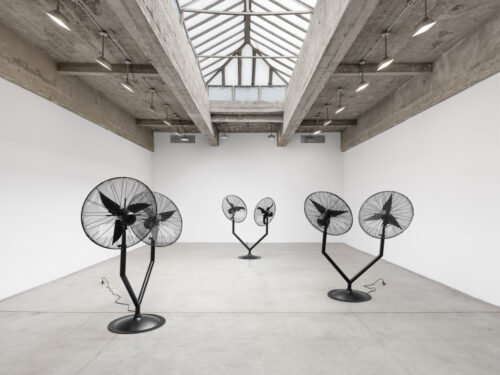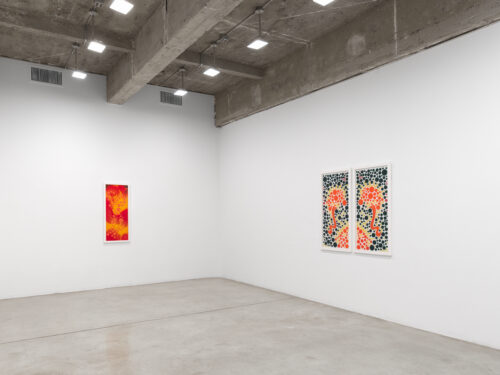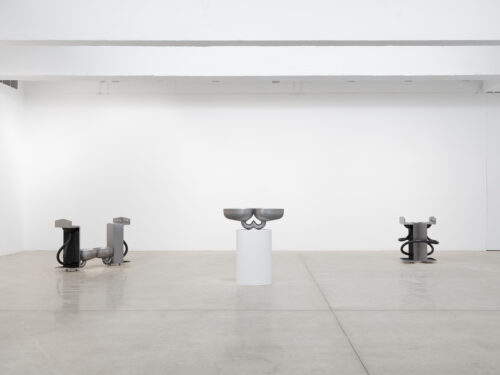Building empathy isn’t an easy task. But this is the challenge that Sherrill Roland confronts in his new exhibition The Turning Away From at the Tanya Bonakdar Gallery. As a whole, his exhibition reflects on the overwhelming dehumanization that incarceration incites, both materially and psychologically. The carceral space is one that violently imposes a forced intimacy, and Roland’s pieces confront this, bringing the viewer towards the feeling of being incarcerated.
In the years since Sherrill Roland was first incarcerated in 2013, his art is not the only thing that has grown and evolved. Private prisons in the United States have expanded. More and more people are being incarcerated. ICE agents are kidnapping people and filling such prisons as I write this. The tentacles of the carceral have grown and sought to grasp everything within their reach. And while Roland’s earlier pieces, like The Jumpsuit Project, dealt more directly with his own body and his own personal experience of being incarcerated, The Turning Away From brings the viewer to a state of incarceration rather than bringing the state of incarceration to the viewer.
While the material and psychological dehumanizations of the carceral system may often be turned away from, Roland invites the viewer to actively turn towards the realities of imprisonment with pieces that both bring to life the housing unit and an imagined reality. The serrated fans of the piece Conflict Resolution don’t necessarily invite the viewer to stick their hand in, but the potential is there. The question is whether it’s possible to be open without the potential of danger. Beyond this the fans evoke the literal heat that imprisoned people are frequently tortured by. Like the fans themselves, conjoined at the base, the impressions are multiple.
Roland was exonerated in 2015, but the effects of imprisonment have remained in him and his art. Even something as simple as getting supplies for artistic projects bear a reflection on his time spent incarcerated. When I spoke with Roland, he explained how “The fact that I can go, I can walk bike get a ride to a store, get materials, is something that I could not do while I was incarcerated and if I try to keep the integrity—of the honest integrity—of what it was like inside, which was [that] we were limited in everything and to have something meant something. You know, to get an ink pen it was communal effort—for me to draw a portrait for a happy birthday card inside was like a communal effort.” It’s for this reason as well that Roland continues to use supplies in his art that he had access to during his incarceration. Pieces like 168.832, Until you’re a reason folks gots to pour out, and And you know I ain’t lying, that’s just how family talk use Kool-Aid for their vibrant colors, reframing the material into unexpected forms of brightness. These pieces also play with the form that color-blindness tests take, provoking the viewer not only the wordplay of the idea but literal separation of difference. Maybe the image is incredibly noticeable. But if it’s so noticeable, why is it turned away from?
Roland’s pieces not only bring to mind how the simplest task is transformed while imprisoned, but are crafted with this understanding. The sculpture Courtship I literally renders this with the most natural of human acts as a conjoined spectacle. The sculpture elicits not only the physical impossibility of using such a device when trying to evacuate the waste from your body, but the uncomfortable closeness of forced intimacy. Because as with the fans, nothing is alone. Even Portraits #826 is multiple. A forced communal commonality.
The Turning Away From tries to bring the viewer to consider the experience of incarceration. Roland explains how “There’s many ways we can tell the story, and those stories are real, and I’m trying to add another perspective. The more perspectives we can have, outside perspectives, somehow we can render a real thing in our minds, even though someone who is participating in it has never experienced it yet. I don’t even really want people to feel like they’re incarcerated, but I am most definitely trying to get you to consider what it feels like to be incarcerated.” In doing so, the viewer contends with the question of how to feel empathy without being in the same situation. While still being in an art gallery, Roland’s pieces reference aspects of the prison housing unit, putting the viewer in a liminal state where they are both in and out of prison, both able and unable to feel the realities of imprisonment.
Is it possible to empathize with people who have made decisions that you never thought you would make? Is it possible to truly consider oneself incapable of making such decisions? As Roland stated, “When you’re on an edge or a ledge, so to speak, are you capable of doing something that’s bad for something good because you’re in that dire need. And that is a hard thing to consider if you’ve never been to your respectfully relative ledge. And so I’ve learned to have a little more empathy about seeing people at their edge because we all will be unrecognizable if we’ve ever reached our own.”
Can art bring the viewer to consider such a ledge? I think so, but it requires the viewer to be open to such a consideration. It’s easy to turn towards an art gallery and engage momentarily with such concepts, but once you leave the space the turning away becomes normalized once again. This was something that Roland himself contended with after leaving prison. “Once I got out and I realized how easily it was to shy away from that honesty and dress things up, I lost it. I felt it very hard to get it out in the world because there’s so many ways we can avoid it, hide it, and manipulate it. And in there, it was just so simple for the worst reasons.” It’s easy for our environments to become a shield against the discomfort, and while such a state is difficult to find in prison, those who are outside are rarely able to allow themselves the transgression into the different spaces. Unless there are loved ones who are trapped within the carceral system, imprisonment is seen as the outlier, something that is deserved to all those who find themselves in its grasp. For those who avoid it it’s something that doesn’t need to be considered, something that they think has no effect on their lives.
But the carceral system affects everyone, regardless of whether or not those effects are felt within a particular body. Roland’s pieces push back against the dichotomy of innocence and guilty, a dichotomy that many are all too willing to accept, despite these categories being invented political categories that have little to do with morality. Because no one is entirely innocent just as no one is entirely guilty. We are all criminals to an extent, and ever more so if we continue to allow the state to act as the biggest criminal of all.
Why is it so important not to turn away? And is turning towards merely just the first step? While these pieces don’t strive to answer such questions, the provocation of these questions is there and for many is an important first step. Nothing will change in the American carceral system as long as people are willing to turn away. And ultimately, that is exactly what the government wants. To distract people in order to keep them turned away. It is only by forcing ourselves to turn towards that we will start to break our own biases. Maybe this can happen without everyone being incarcerated at one point or another. Ultimately, imprisonment isn’t something to be wished on anyone. But if the feeling of imprisonment can lead to radical change, then it’s time we turned towards engaging with such feelings.
The Turning Away From can be seen at the Tanya Bonakdar Gallery from June 5 to July 31, 2025, at 521 W 21st St, New York City, NY 10011.
Follow the artist on Instagram @sherrillroland



